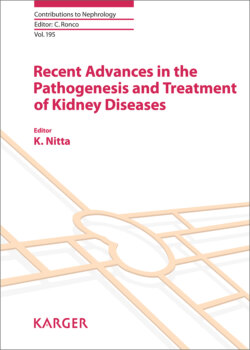Читать книгу Recent Advances in the Pathogenesis and Treatment of Kidney Diseases - Группа авторов - Страница 12
На сайте Литреса книга снята с продажи.
The Roles of Caveolae in the Kidney
ОглавлениеA variety of roles for caveolae in the kidney have been reported in previous studies. In rat kidneys exhibiting anti-Thy-1 nephritis, Cav-1 was highly expressed by glomeruli; Cav-1 on glomerular mesangial cells was suspected to play a role in the pathogenesis of mesangial proliferative glomerular disease through PDGF signaling [10]. In contrast, overexpression of Cav-1 in mesangial cells suppressed basic fibroblast growth factor-induced and PDGF-induced activation of p42/44 mitogen activated protein kinase, Raf-1 and extracellular signal-regulated protein kinase, thereby suppressing mesangial cell proliferation [11]. Exposure to TGFβ and high glucose increased fibronectin expression and RhoA activation through Cav-1 phosphorylation, whereas suppression of Cav-1 prevented an increase in fibronectin expression [12, 13]. However, the detailed roles of Cav-1 in mesangial cells are still intensely debated. In the parietal epithelial cells of Bowman’s capsule in normal kidney, Cav-1 is strongly expressed; however, in pediatric patients with focal segmental glomerulosclerosis and lupus nephritis, Cav-1 expression decreased as a response to cellular reconstruction [14]. In a study of acute kidney injury, Cav-1 was expressed in injured proximal tubules that exhibited loss of basement membrane, as well as in apoptotic cells [15], and its expression was correlated with the induction and maintenance phases of acute kidney injury [16]. In cases of obstructive nephritis, Cav-1 expression by both proximal tubule epithelial cells and collecting duct epithelial cells resulted in the enhancement of angiotensin II, decrease in endothelial nitric oxide synthesis, and increase in the severity of tubulointerstitial injury [17]. Further, BK virus, which induces viral nephritis after renal transplantation, was observed to enter into tubular proximal epithelial cells through caveolae, facilitating its ultimate replication in host cells [18]. As discussed here, the detailed roles of caveolae in tubular epithelial cells continue to be unclear.
Table 1. Caveolae-associated signaling molecules and transduction proteins
| Receptors G protein coupled receptors (adrenergic, muscarinic, opioid, angiotensin II, adenosine, bradykinin, endothelin, serotonin, etc.) Transforming growth factor-β receptors Tyrosine kinase (insulin, EGF-R, PDGF-R, VEGF-R) |
| Interacting proteins eNOS Src Ras-MAP kinase Protein kinase A Protein kinase Cα MEK/ERK Phospholipase D1 |
| Membrane proteins CD36, SR-BI (lipoprotein receptor) Gp60 (albumin receptor) PV-1 P-glycoprotein MMP-1 MMP-2 uPAR |
| Ion channels Transient receptor potential cation L-type Ca2+ KATP Ca2+ pumps |
Fig. 1. Caveolae and caveolin-1 expression. a In electron micrographs depicting AL-amyloidosis, caveolae in glomerular endothelial cells are present in the cytoplasm and on both cell surfaces, facing the capillary lumen and glomerular basement membrane (black arrows); fenestrae are also present (arrow heads). Caveolae are present in the cytoplasm of glomerular epithelial cells (white arrows), and foot processes are fused. b In an immunofluorescence study of membranoproliferative glomerulonephritis, Caveolin-1 was highly expressed on the capillaries in the glomeruli. It was also detected on the arterioles.
